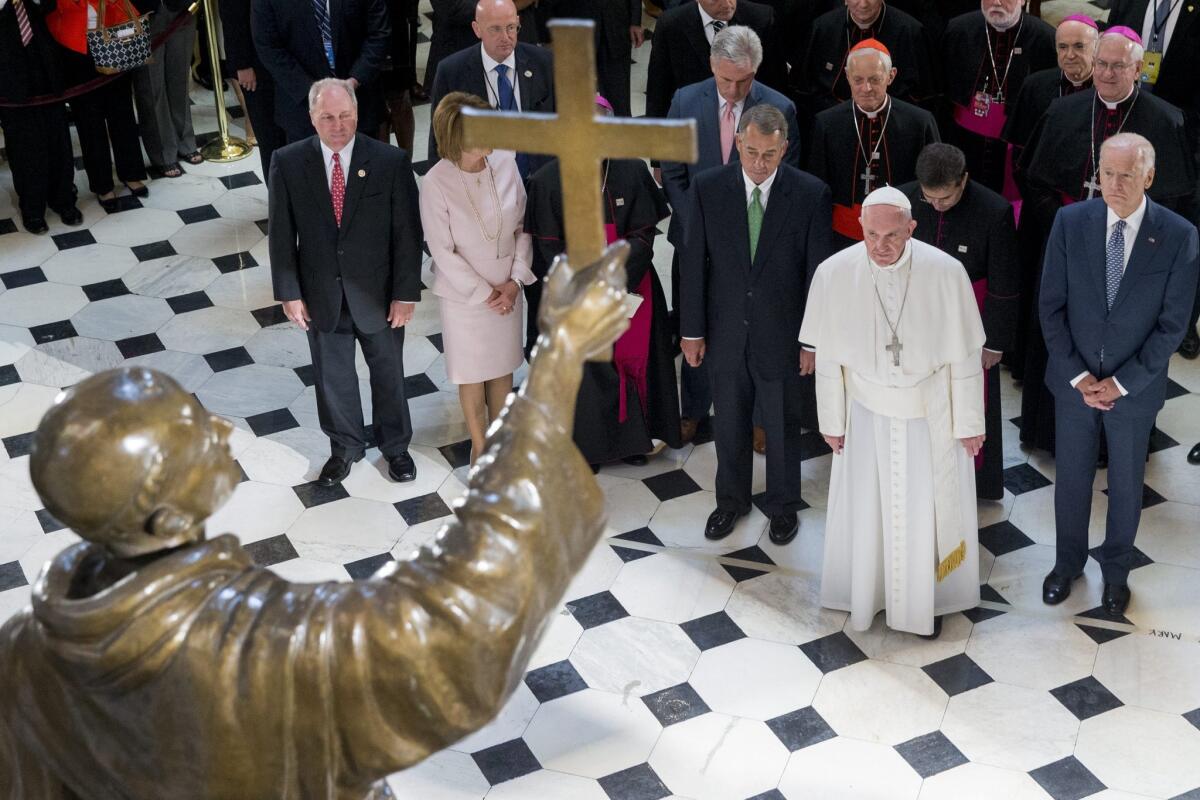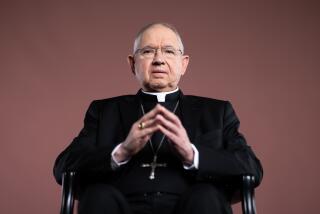Op-Ed: Pope Francis gives America its first Latino saint

Pope Francis stands with U.S. Speaker of the House John Boehner, third from right, and Vice President Joe Biden right, before a sculpture of Spanish-born Junipero Serra, the Franciscan friar known for starting missions in California.
“What do you know about Junipero Serra?”
I put that question to a couple who had waited in line for more than three hours to get into the security gates for Pope Francis’ Mass on Sept. 23 in Washington, canonizing the Franciscan friar who had built the first nine of the chain of Spanish missions along the California coast.
“Nothing!” answered Michael and Carol Fortunato in unison. They had driven to Washington from Philadelphia strictly to see the pope.
Michael Fortunato, an employment lawyer who practices near Philadelphia, elaborated: “If you asked me the name of the missionary who founded the mission in what is now San Diego, I’d draw a blank.”
“I don’t know,” echoed Robin Ridgley of Adelphi, Md., when I asked her the same question. “But I’m going to read all about him in this packet,” she added, gesturing toward a plastic bag of handouts that most of the attendees had received.
These answers reflect the ignorance, or near-ignorance, of most people outside of California about the man who is an integral part of the state’s history — which makes one wonder why Francis chose Washington, D.C., and not California, where Serra is buried at the mission that he founded, as the site of the canonization.
In California, Serra’s reputation is that of a prayerful, self-abnegating 18th-century friar devoted to saving the souls of the California tribes and protecting them from the sometimes brutal Spanish military in charge of claiming the territory for Spain. Or, according to Native American activists and their supporters protesting the canonization, he was a brute who enslaved Native Americans, had them punished with whips and chains and turned the missions into “picturesque charnel houses,” as one critic wrote.
Non-Californians love to visit the coastal tile-roofed missions as tourists, but neither Serra nor the California Native Americans mean much to them. There were no reported anti-Serra protests in Washington on Sept. 23, for example.
There’s a handy explanation for this silence: The California natives whom Serra and other Westerners encountered left only fleeting evidence of themselves and their culture.
About 225,000 of them were living in California when the Spanish arrived, but they lived in isolation, even from each other. There might have been as many as 500 tribes of 50 to 100 members apiece — more like extended families — and speaking more than 300 dialects of 100 different and sometimes unrelated languages.
Hunter-gatherers for thousands of years, the California tribes never developed agriculture because they didn’t have to in a terrain that teemed with game, birds, fish and seafood. They made beautiful baskets and shell ornaments but almost nothing else, even clothes, let alone the impressive adobe masonry of the Pueblo tribes of New Mexico or the totem poles of the Native Americans of the Pacific Northwest.
They also died in huge numbers after the European encounter, mostly from the white man’s diseases. Their population fell by a third under Spanish and Mexican rule, and then by an additional 80% after the Gold Rush, when American settlers began flooding into California in germ-spreading droves. Not surprisingly, the National Museum of the American Indian in Washington, which houses thousands of Native American artifacts, records the California tribes’ presence west of the Sierra Nevada with just a handful of items.
Perhaps Pope Francis chose Washington as the site of Serra’s canonization precisely to avoid the likely California-centric focus that a California canonization would have entailed. His Mass, in Spanish with a heavy admixture of Latin, seemed aimed instead at emphasizing his solidarity as an Argentine with America’s 54 million-strong Latino population as a whole, whose members’ ethnicity and culture are mixes of Indian with Spanish elements. The music that accompanied the Mass emphasized this admixture, combining traditional chants with Latino melodies, including echoes of the criollo compositions of colonial Latin America.
The Washington area is 12% Latino, and Latinos turned out by the thousands for both the Mass, where the main language I heard around me was Spanish, and Francis’ parade along the National Mall. Many wore white “Caminando con el Papa Francisco” T-shirts, and a few wore orange T-shirts saying “Canonización de Fray Junipero Serra.” America’s most prominent Latino bishop, Archbishop José Gomez of Los Angeles, in the pages of The Times, called Serra’s canonization “a milestone for Latinos everywhere.”
That about summed it up. Francis was giving America its first Latino saint. By picking Washington, America’s capital, he was ensuring that Serra would finally be a saint whom all Americans would know about. The pope ended his sermon at the Mass with Junipero Serra’s motto, “Adelante,” meaning forward. He was turning a Californian into a universal figure.
Follow the Opinion section on Twitter @latimesopinion and Facebook
More to Read
A cure for the common opinion
Get thought-provoking perspectives with our weekly newsletter.
You may occasionally receive promotional content from the Los Angeles Times.










